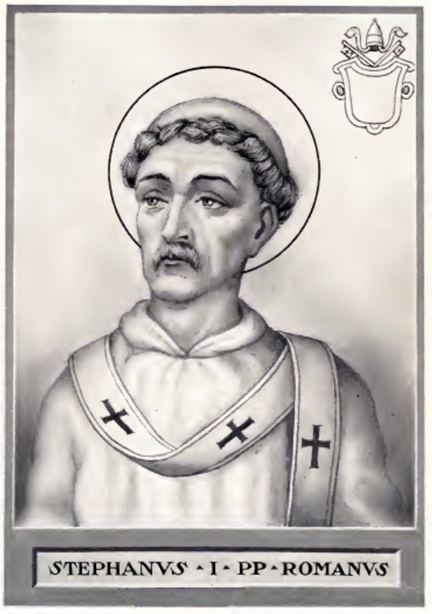Papacy began 12 May 254 Name Pope I Term ended August 2, 257 AD Feast day 2 August, 3 August | Birth name Stephanus Successor Pope Sixtus II Papacy ended 2 August 257 | |
 | ||
Similar People Pope Lucius I, Pope Pius I, Pope Sixtus I, Pope Alexander I, Pope Anastasius I | ||
Pope Stephen I (Latin: Stephanus I; died 2 August 257) was the Bishop of Rome from 12 May 254 to his death in 257. Of Roman birth but of Greek ancestry, he became bishop after serving as archdeacon of Pope Lucius I, who appointed Stephen his successor.

Biography
Following the Decian persecution of 250–251, there was disagreement about how to treat those who had lapsed from the faith, and Stephen was urged by Faustinus, Bishop of Lyon, to take action against Marcian, Bishop of Arles, who denied penance and communion to the lapsed who repented, the position called Novatianism, after Novatian, later declared a heretic, who held for the strictest approach.
The controversy arose in the context of a broad pastoral problem. During the Decian persecution some Christians had purchased certificates attesting that they had made the requisite sacrifices to the Roman gods. Others had denied they were Christians while yet others had in fact taken part in pagan sacrifices. These people were two called "lapsi". The question arose that if they later repented, could they be readmitted to communion with the church, and if so, under what conditions.
Stephen held that converts who had been baptized by splinter groups did not need re-baptism, while Cyprian and certain bishops of the Roman province of Africa held rebaptism necessary for admission to the Eucharist. Stephen's view eventually won broad acceptance in the Latin Church. However, in the Eastern Churches this issue is still debated.
He is also mentioned as having insisted on the restoration of the bishops of León and Astorga, who had been deposed for unfaithfulness during the persecution but afterwards had repented.
The Depositio episcoporum of 354 does not speak of Pope Stephen I as a martyr and he is not celebrated as such by the Catholic Church, in spite of the account in the Golden Legend that in 257 Emperor Valerian resumed the persecution of Christians, and Stephen was sitting on his pontifical throne celebrating Mass for his congregation when the emperor's men came and beheaded him on 2 August 257. As late as the 18th century, what was said to be the chair was preserved, still stained with blood.
St Stephen I's feast day in the Roman Catholic Church is celebrated on 2 August. In 1839, when the new feast of St Alphonsus Mary de Liguori was assigned to 2 August, Saint Stephen I was mentioned only as a commemoration within the Mass of Saint Alphonsus. The revision of the calendar in 1969 removed the mention of Saint Stephen I from the General Roman Calendar, but, according to the General Instruction of the Roman Missal, the 2 August Mass may now everywhere be that of Saint Stephen I, unless in some locality an obligatory celebration is assigned to that day, and some continue to use pre-1969 calendars that mention a commemoration of Saint Stephen I on that day.
Pope Saint Stephen I is the patron of Hvar and of Modigliana Cathedral.
